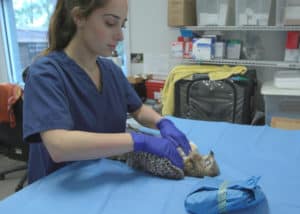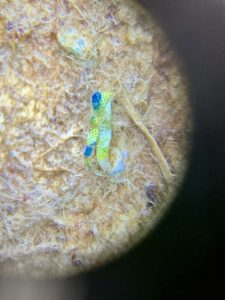Share this article
Microplastics detected in birds of prey for first time
For the first time, researchers have detected microplastics in the guts of birds of prey. These tiny particles, which may come from clothes, cosmetics or the breakdown of larger plastics — have turned up in a variety of ocean-dependent species, but this is the first time they’ve been seen in birds of prey.
“Microplastics is still a really new topic,” said Linda Walters, a Pegasus Professor of Biology at the University of Central Florida. “There are lots of groups of organisms that we still have not examined, with birds of prey included among them.”
Julia Carlin, an undergraduate student working in Walters’ marine biology lab at the time, wanted to venture beyond marine biology and study species more closely related to her pre-vet major. When staff from the Audubon Center for Birds of Prey in Maitland Florida, a rehabilitation center that helps injured birds, visited her school, Carlin got the chance to view all types of birds of prey and was in awe.
“These birds are magnificent,” said Carlin, who is now a doctor of veterinary medicine candidate at North Carolina State University College of Veterinary Medicine. “Knowledge drives passion, and I wanted to learn as much as I could about them. I wanted to know how much plastic they were eating ultimately so this research can teach others and they can become passionate about plastic pollution, too.”
She knew that microplastics — plastic particles 5 millimeters or smaller — had already been found in seabirds, but she wondered about birds of prey, especially since they are at the top of the trophic pyramid and can impact the rest of the ecosystem. After telling the Audubon scientists about her idea, they granted her access to dead and dying birds study them.
“Such access is one of the reasons microplastics in birds of prey had not been previously examined,” Walters said. “Julia next had to develop methods that worked with these animals — not a simple task! Julia’s effort documents the power of undergraduate research experiences — on both Julia’s career success and in adding to our knowledge on important topics.”

Image Caption: Julia Carlin dissects the digestive tract of a red-shouldered hawk. While all birds of prey she collected had microplastics in their guts, red-shouldered hawks had the highest concentrations. Credit: Linda Walters, UCF Department of Biology
Carlin led the study published in Environmental Pollution in which she and multiple colleagues collected bird carcasses — including various owls, hawks, ospreys (Pandion haliaetus) and vultures — that came to the Audubon Center for Birds of Prey for five months. The birds they collected, including 63 birds from nine different species, either died naturally in the wild or were captured within 24 hours of their care, so that their last meal came from the wild.
After dissecting the digestive tracts, researchers chemically digested and filtered the contents and examined the filters under a microscope to determine the abundance and diversity of microplastics.
Sometimes that meant using tweezers to dissect smaller species like screech owls or breaking a clavicle to dissect huge black vultures (Coragyps atratus).
The team found that every bird they brought in contained microplastics.
“That’s the reality, but it makes you have a sad overall feeling about this,” Walters said. “This is a human problem that is impacting every species studied to date”.
Red-shouldered hawks (Buteo lineatus) had the most microplastics of the species they collected. Carlin said this is likely because they are feeding on rodents or other species that tend to spend time around trash cans and landfills, where there’s plenty of plastic.

Tiny bits of plastic were found inside a vulture’s stomach. Credit: Linda Walters, UCF Department of Biology
In some cases, Walters said, the birds may have eaten the plastics intentionally, mistaking them for a worm or insect. In others, they may have taken them in by eating prey that had consumed them or by drinking water containing microplastics.
How microplastics may affect the birds is unclear. Previous studies have documented they can inflame the digestive tract, which could decrease feeding, make the birds more lethargic and may even cause them to reproduce less or perish, Walters said. “Those studies right now are pretty much lab studies using large volumes of a single type of plastic, so it’s a little hard to relate that to what we have collected in the field,” she said.
Carlin said that the most commonly consumed microplastic was a form of processed cellulose, which is found in synthetic fibers. Those are often found in beach towels or clothing, she said, and when they’re washed in the washing machine, they can end up in the ocean.
“It’s an invisible monster invading the ecosystem from everyday items such as clothing and towels and boat ropes,” she said. “One thing people can do is start being aware of the things we can do to be a more conscious consumer. They can look at where they’re buying clothes from and make sure it’s not from a plastic source.”
She also said having filters at water treatment plants to help catch smaller plastics can be helpful as would not having open landfills.
Header Image:
Julia Carlin dissects the digestive tract of a red-shouldered hawk. While all birds of prey she collected had microplastics in their guts, red-shouldered hawks had the highest concentrations.
Credit: Linda Walters, UCF Department of Biology








